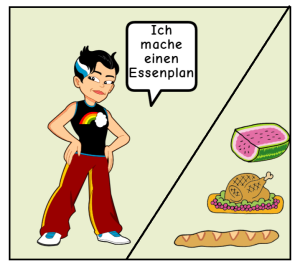6.11 Eine Einkaufsliste schreiben

Guten Tag!
Zum Aufwärmen machen wir unseren Tagesminiplausch und eine Wiederholung.
Wiederholung
In the previous lesson, you learned about the diversity of foods in Germany, how to express that you are hungry and/or thirsty, and how to say want you want to eat. Let’s review what you have learned.
For a moment inhabit your German child persona. You feel hungry and thirsty. How would you express that? Now (like a demanding child 🙂) say want you want to eat. Write these sentences in your written journal. Then practice reading them aloud in your audio journal.
Lektionsüberblick
When you are in Germany, you will likely have many meals at home, which means you will need to shop for groceries (Lebensmittel einkaufen). In this lesson, we will prepare for your shopping, by thinking about what you will eat for the next meals and then writing a shopping list. In the end, you will be able to 1) make a meal plan and 2) write a shopping list based on your meal plan.
1) Der Plan (The plan)
It’s time to plan your meals for the week. If you are not a plan-ahead type, that’s okay. It will still be a great opportunity to review the days of the week, meals, and food.
 |
Look at Sofia’s Essenplan below.
What foods do you recognize?
|
| Montag | Dienstag | Mittwoch | Donnerstag | Freitag | Samstag | Sonntag | |
|---|---|---|---|---|---|---|---|
| Frühstück | Joghurt mit Beeren | Bagel mit
Frischkäse |
Joghurt mit Beeren | Bagel mit
Frischkäse |
Joghurt mit Beeren | Ruhrei mit Speck | Pfannkuchen mit Ahornsirup |
| Mittag-essen | Belegtes Brot mit Aufschnitt | Suppe | Suppe | Salat mit Tomaten und Sauce | Belegtes Brot mit Aufschnitt | Hamburger und Pommes Frites | Nudeln mit Sauce |
| Abend-essen | Ofenkartoffel | Taco Dienstag | Reis mit Hühnerfleisch | Reis mit Gemüse | Gemüse-Curry | Sushi | Pizza mit Salami |
| What is missing from Sofia’s Essenplan? Can you think of anything that needs to be added? (Consider: additional Mahlzeiten that we have discussed, Getränke, etc.) |
|||||||
Jetzt bist du dran!
Norddeutschland im Blickpunkt

Lübeck ist die zweitgrößte Stadt in Schleswig-Holstein mit knapp 217.000 Einwohnern. Sie liegt 68,4km östlich von Hamburg an der Lübecker Bucht einer Meeresbucht der Ostsee. Die früheste Überlieferung des Namens Lübecks in der Form Liubice ist aus der 2. Hälfte des 11. Jahrhunderts. Lübeck war im Mittelalter eines der bedeutendsten Mitglieder der Hanse und prägte den Handel im gesamten Ostseeraum. Die gut erhaltene Altstadt gehört heute zum UNESCO-Weltkulturerbe. Lübeck ist auch für ihr Lübecker Marzipan weltweit bekannt. Zwei der größten Hersteller dieser Süßware aus gemahlenen Mandeln und Zucker, Niederegger und Mest, haben ihren Hauptsitz in Lübeck.

Lübeck is the second-largest city in Schleswig-Holstein with just under 217,000 inhabitants. It is located 68.4 km (42.5mi) east of Hamburg on the Bay of Lübeck, an inlet of the Baltic Sea. The earliest recorded mention of Lübeck’s name in the form Liubice dates back to the second half of the 11th century. Lübeck was one of the most important members of the Hanseatic League in the Middle Ages and shaped trade throughout the Baltic region. The well-preserved old town is now a UNESCO World Heritage Site. Lübeck is also known for its marzipan. Two of the largest producers of this confection of ground almonds and sugar, Niederegger and Mest, have their headquarters in Lübeck.
2) die Einkaufsliste schreiben (writing your shopping list)
Now let’s build your shopping list based on what you wrote in your Essensplan. You will most likely need food from the following categories: Obst, Gemüse, Fleisch/Fisch, Milchprodukte, anderes, Getränke.
Here is what Sofia will need for the first two day of her Essensplan to give you an idea:
EinkauflisteObst Erdbeeren Heidelbeeren
Gemüse Kartoffeln
Fleisch/Fisch Schinken-Aufschnitt
Milchprodukte Joghurt Milch Butter
Anderes Brot
Getränke Kaffee |
Before you build your list, let’s review the food categories.
Jetzt bist du dran!
Zum Schluß

*As you conclude this lesson, don’t forget to check Canvas!*

Media Attributions
- 1010-1020 banner long large reduced
- Comic made at www.MakeBeliefsComix.com
- holstentor © Rebecca Steele is licensed under a CC BY-NC-SA (Attribution NonCommercial ShareAlike) license
- Private: confidence scale_large horizontal_updated

